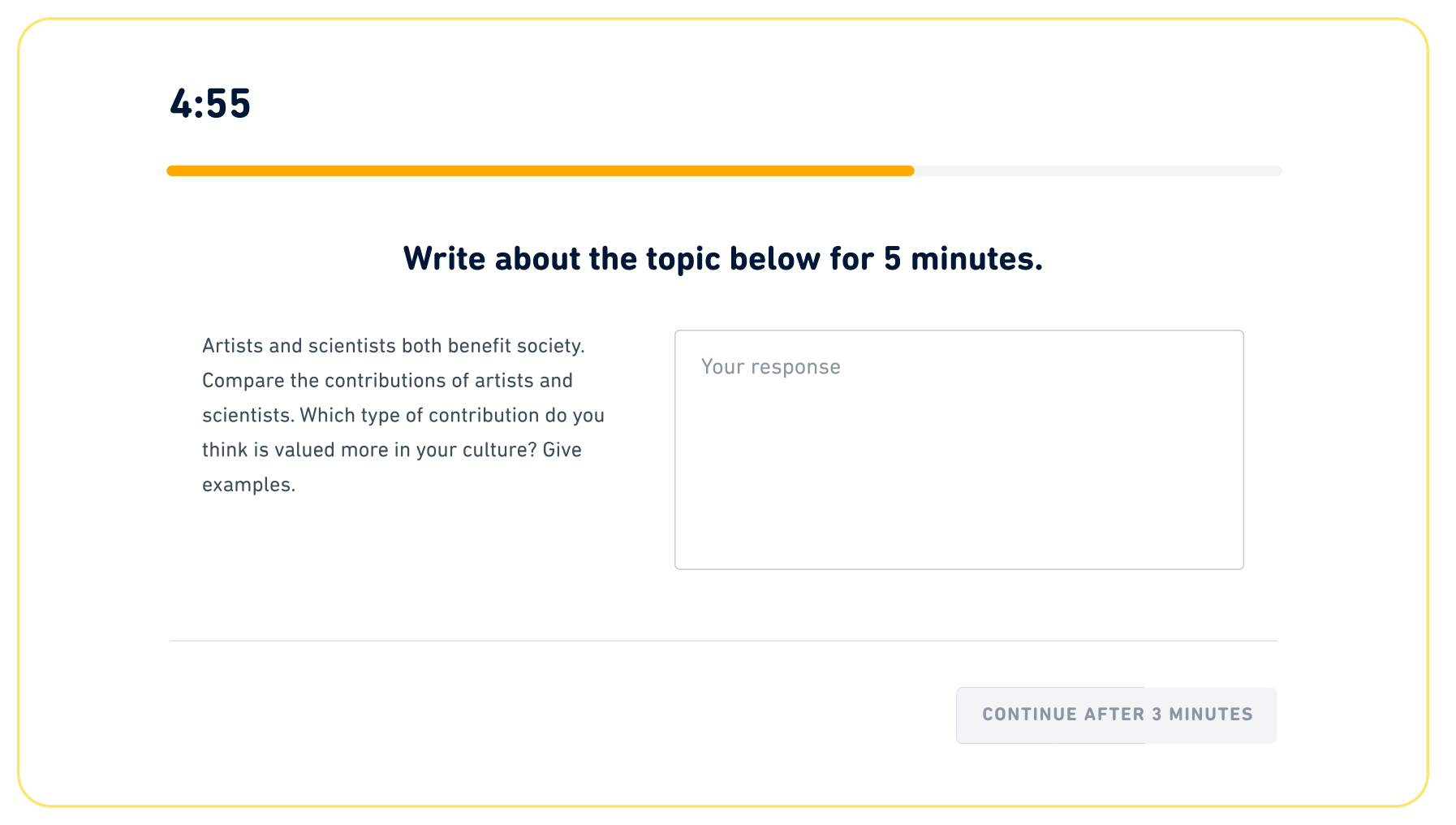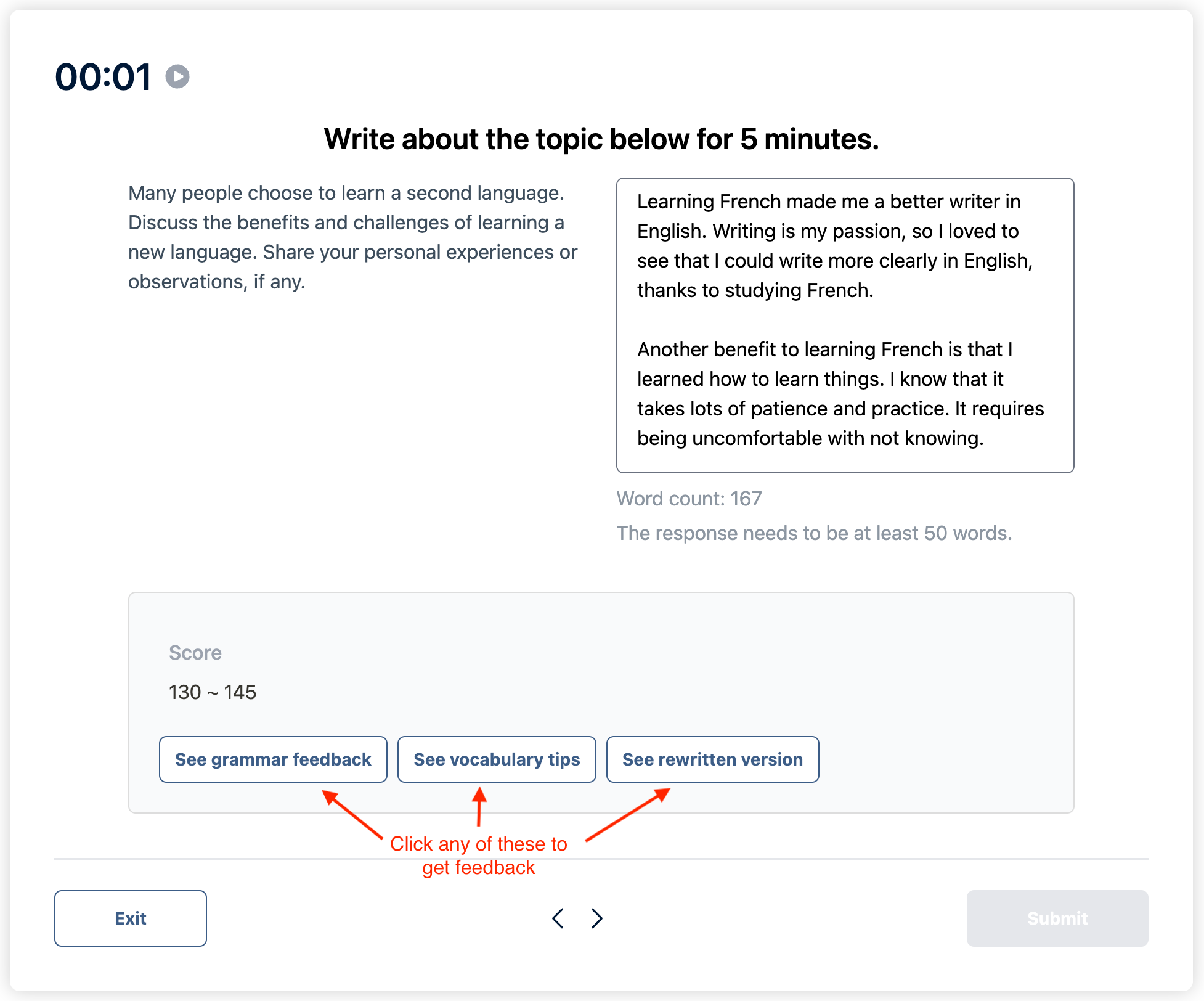"Read, Then Write" - Guide to Duolingo English Test Question (2025)
On 2 April, 2024, the "Read, Then Write" question type will be removed from the Duolingo English Test.
It will be replaced with the new "Interactive Writing" question.
The “Read, Then Write” question is one of the most intimidating on the Duolingo English Test because it’s 5 minutes long! 😲
The good news is that it is easy to prepare for this question. Also, it is essentially the same as the “Writing Sample” question. This means you can learn to improve at both at the same time.
By the end of this post, you will understand how the “Read, Then Write” question works, how you should approach it to get the highest score, and the best way to practice for it.
Table of Contents
- What is the “Read, Then Write” question type?
- Tips to do well on the “Read, Then Write” question
- How to use the I LAST strategy to get a great score
- How to practice the “Read, Then Write” question
- Conclusion
What is the “Read, Then Write” question type?
The “Read, Then Write” question looks like this:

You will have 5 minutes to write about the topic provided. You have to write at least 50 words and for at least 3 minutes.
But, we recommend that you write at least 150 words. The reason is simple: If you don’t write enough, you won’t be able to get a high score. (Later in the post we’re going to look at a strategy that will help you generate ideas and write 150 words.)
Your response to this question counts toward your Literacy and Production subscores. It appears just one time on the test.
Tips to do well on the “Read, Then Write” question
Read the question carefully
This sounds obvious, but it is easy to misunderstand the question or miss important details during the test because you may be nervous or stressed. Slow down and read the question multiple times to make sure you understand it.
Plan your response
We recommend spending 30 seconds thinking through your response before you start to write. You will find it much easier to write once you know what you want to say.
In the next section, we cover the I LAST strategy in depth.
Stay on topic
One of the scoring criteria is “task relevance.” This criteria looks for whether your response is directly related to the provided topic. It is not enough to talk about the topic. Your response has to be directly related to the question and topic.
Having a good strategy and planning your response will really help you stay on topic.
Save time to proofread your answer
If your response has typos, missing words, or other easy-to-fix mistakes, it will be impossible to get a high score. That’s why is crucial that you save time to proofread your response.
For the “Read, Then Write” question, we recommend that you stop writing when there are 1.5 minutes left and using the rest of your time to proofread your response.
But if you don't have 150 words when there are 1.5 minutes left, you should keep writing until you get to 150 then use your remaining time to proofread and edit.
On 2 April, 2024, the "Read, Then Write" question type will be removed from the Duolingo English Test.
It will be replaced with the new "Interactive Writing" question.
How to use the I LAST strategy to get a great score
The key to doing well on Production questions like this one is to use a strategy. The right strategy makes it easy to do all the things you need to do to get a high score.
For the “Read, Then Write” question type, we recommend the I LAST strategy:
- Identify: Identify the topic
- List: List out the tasks Duolingo wants you to perform
- Answer: Answer the question or state your viewpoint directly
- Support: Support your answer
- Three: Provide three examples
Let’s use I LAST in an example. Here is a topic provided by Duolingo:
Artists and scientists both benefit society. Compare the contributions of artists and scientists. Which type of contribution do you think is valued more in your culture? Give examples.
- Identify the topic ⇒ The contributions that artists and scientists make to society
- List out the tasks Duolingo wants me to perform ⇒ Duolingo wants me to:
- Compare the contributions of artists and scientists
- Answer the question, “Which type of contribution do you think is valued more in your culture?”
- Speak about which one is more valued in my culture not to me personally
- Give examples
- Answer the question or state your viewpoint directly ⇒ When Duolingo asks you a specific question in the prompt, answer it directly. I will start my response with, “I think that in my culture the contributions of scientists are valued more.”
- Support your answer & Provide three examples⇒ Now, I need to defend my answer. This is best done by providing examples. Three examples is the perfect amount. I can follow my first sentence with something like, “First, in the United States, the government spends a lot more on scientific research than it spends on cultural institutions like museums or concert halls.”
How to practice the “Read, Then Write” question
Simply writing answers to practice “Read, Then Write” questions won’t help you very much. To improve, you need feedback.
This is where Arno comes in 😁 Arno gives you instant scoring and feedback.
Here is how to use Arno to practice the “Read, Then Write” question.
1) Go to duolingo.goarno.io. If you don’t already have one, just create a free account.
2) Click on the “Read, Then Write / Writing Sample” question type.

3) Go through the steps of I LAST and type in your response.
4) When “1:30” (1.5 minutes) remains on the timer, review your response. Look for obvious mistakes like typos and missing words first, then make other edits.
5) Once you submit your response, Arno will give you a score. You can also see the different kinds of feedback.

6) Look at the other kinds of feedback Arno has for you. Make note of any grammar mistakes you made, suggestions for better vocabulary words, and any ideas for how you can write better by emulating the rewritten version.

7) Click the right arrow at the bottom to proceed to the next question. In Arno, there are unlimited practice questions!

Conclusion
On 2 April, 2024, the "Read, Then Write" question type will be removed from the Duolingo English Test.
It will be replaced with the new "Interactive Writing" question.
Although the “Read, Then Write” question is challenging, now you understand it and, more importantly, you know how to do well on it. By using Arno to practice with the I LAST strategy, you can get great at this question!
Arno is a great way to practice not just the “Read, Then Write” question but all question types on the Duolingo English Test. To get started, just click below.
